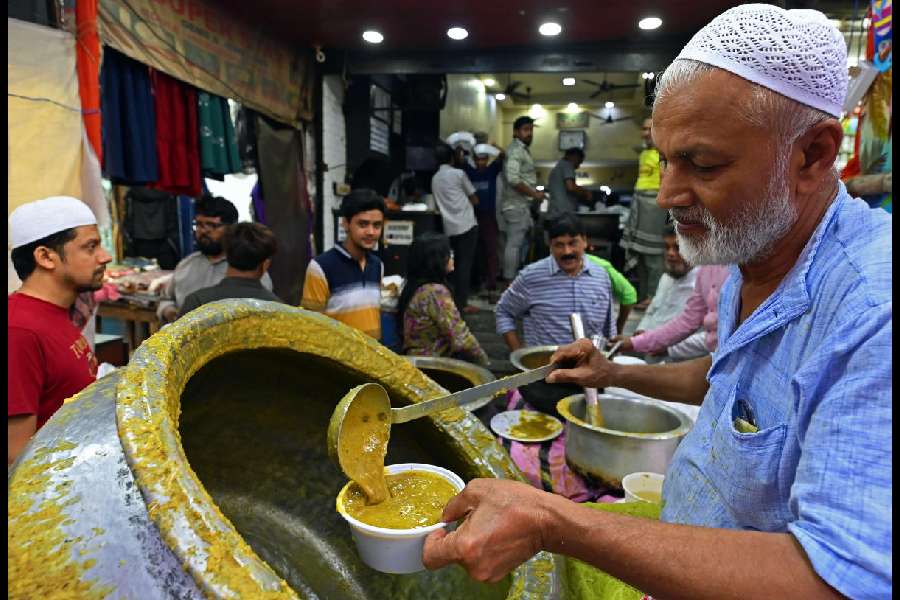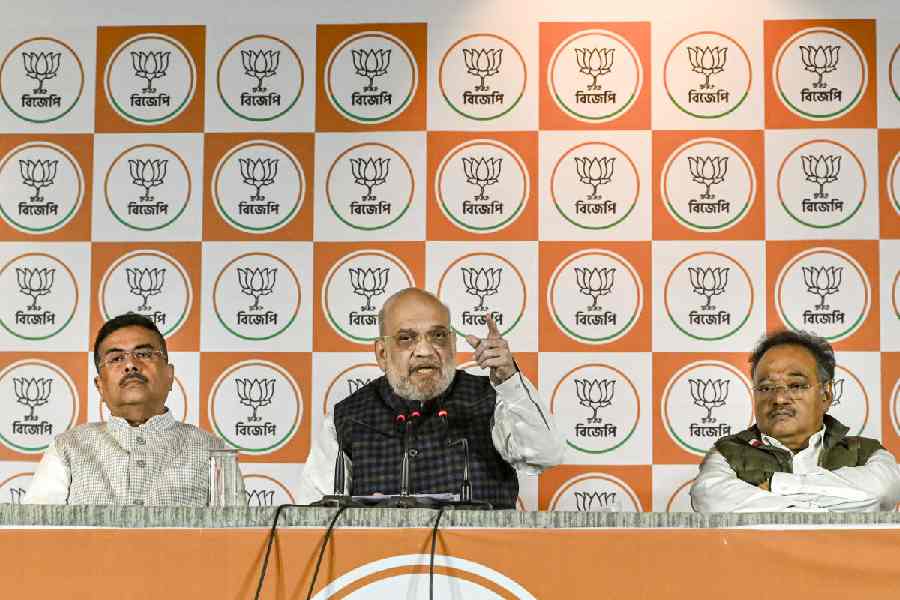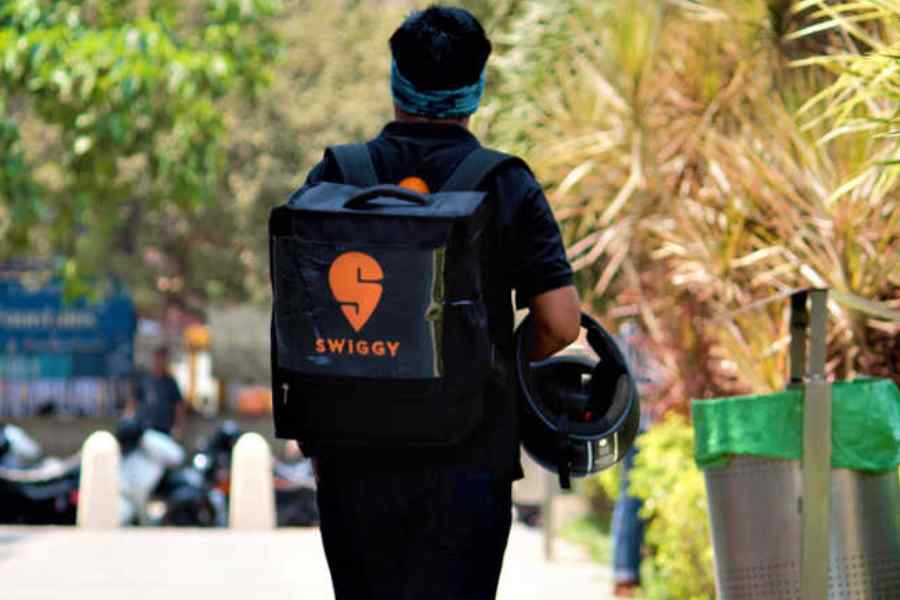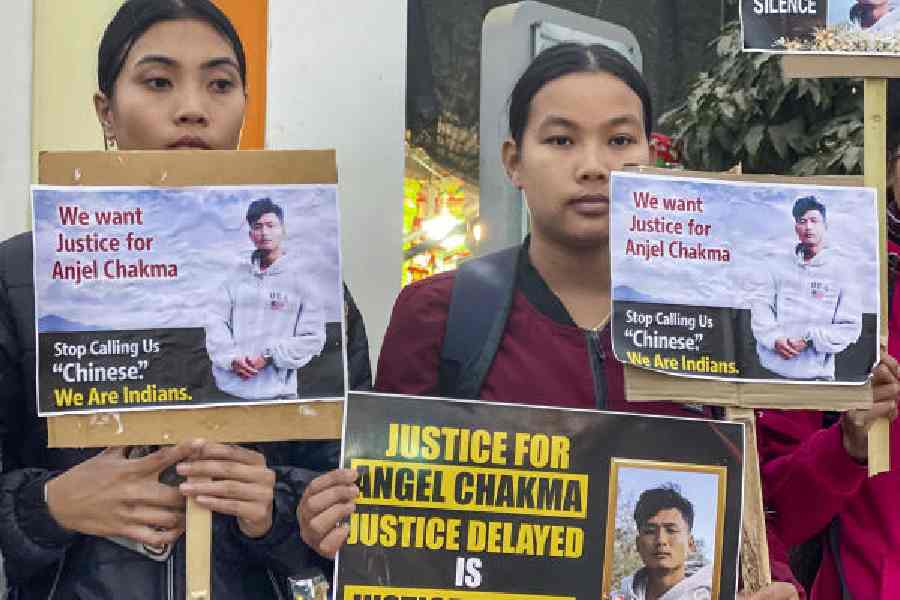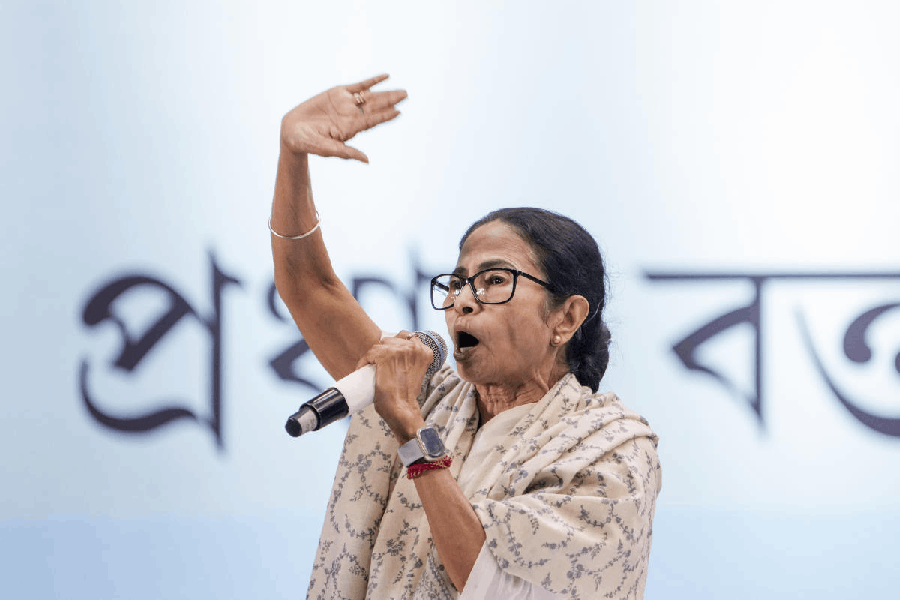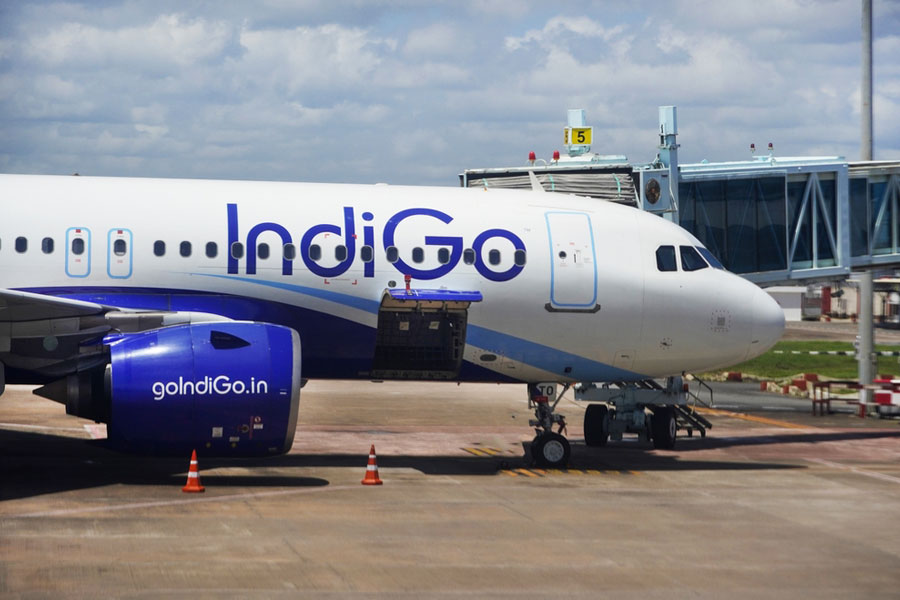Mohammad Sanaullah, 55, grew up in the lanes of Calcutta. He says, “As per the rules of the Ramzan fast or roza, a person is supposed to eat a morsel of food immediately after the call to evening prayers. Wherever a person might beat that point of time, he is expected to eat something and break the fast.”
Sanaullah offers this by way of explanation for the plethora of food stalls dotting the lanes leading to mosques and markets during this period.
Of late, iftar street food in Calcutta is something to take note of. While many of the eateries function all through the year, there are others that appear only in the month of Ramzan.
Zakaria Street — which runs past Nakhoda Masjid in central Calcutta — for all its social media exposure, has not always been a food market. Aftab Ahmed Khan, who is a resident of neighbouring Phears Lane, says, “I have been going to Zakaria Street for the last 50 years. Back then, it was not an organised market. You would find a little bit of everything, including clothes and food.” Mohammed Shahbuddin, who owns a restaurant there, says, “It is the bloggers who made Zakaria Street so famous. But we have always been here.”
According to Khan, the tradition of Ramzan street food is a fairly new trend, most likely 15 to 20 years old.
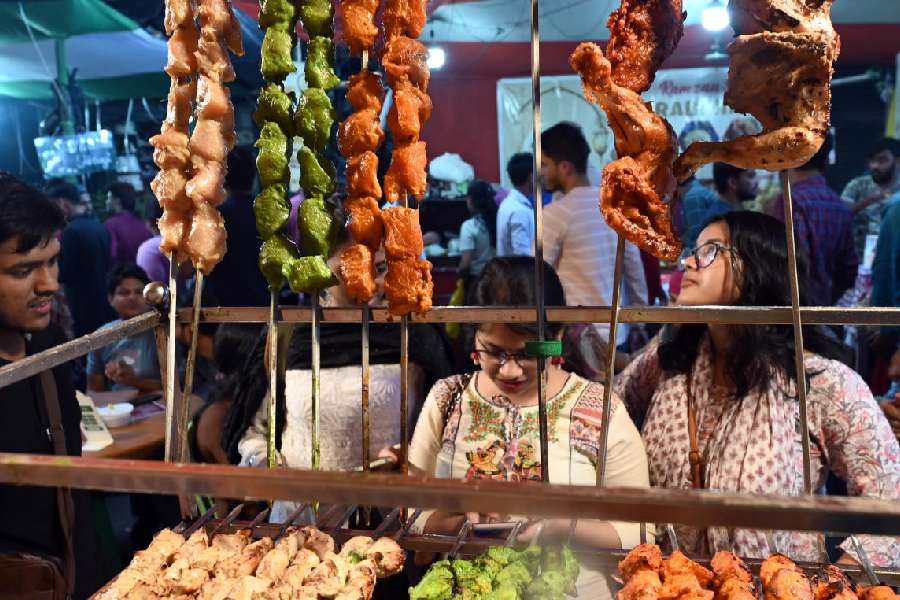
Samim Ahmed, who teaches in Belur’s Ramakrishna Mission Vidyamandira, says, “In Murshidabad, when Mir Jafar was the nawab, there was a tradition of feeding people after the day’s fast was over. MirJafar’s wife Munni Begum used to arrange an iftar spread for thousands of people every evening. Later, the local people took this tradition to the streets of Murshidabad.” Ahmed continues, “In Murshidabad, people came for work. There were karigars, coolies, contractual labourers. They started buying food from these commercial establishments.”
Ahmed cannot say when this trend travelled to Calcutta and why. But growing up in the 1980s, he remembers thelawalas peddling ghugni and fritters as “iftar ka khana”. He continues, “It was the migrants and that too from the labouring class who would buy this food. They neither had the means nor the time to cook after an entire day’s work and fast.”
Most of these iftar markets sell dates. The ones from Jordan and Saudi Arabia are oblong and priced at ₹2,000 a kilo, the cheaper ones are locally packed, and sell for ₹100 a kilo. Around this time, dry fruit sachets also appear miraculously at anything between ₹30 and ₹50 a pack.
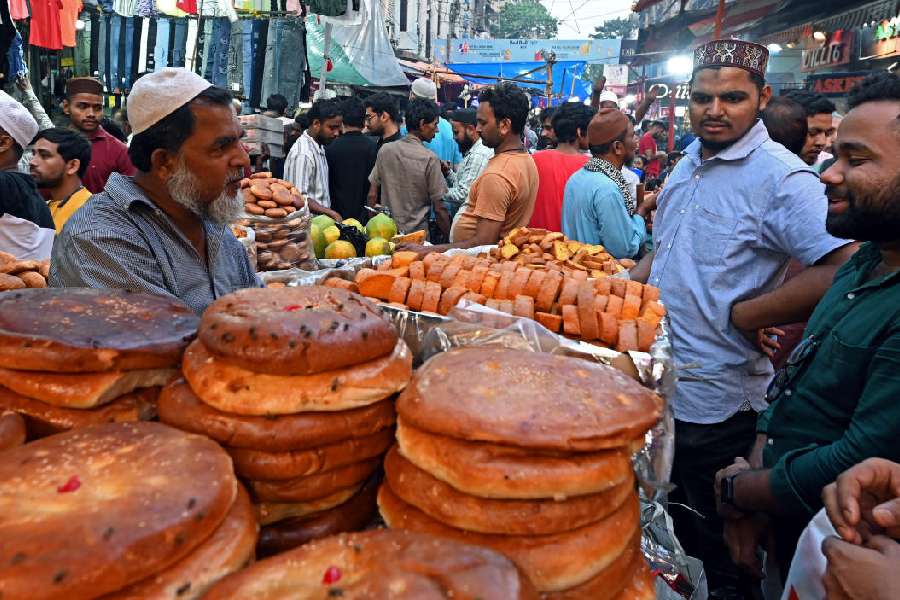
Picture by Sanat Kr Sinha
Says Ahmed, “Dates grow abundantly in Arab countries. In India, people used to break the Ramzan fast by eating slices of ginger or soaked raw rice or just water. In many parts of Bengal, to date, people break the fast with chire.” He adds, “Iftar does not mean a grand feast.”
Writer Haripada Bhowmik proffers another theory. He says, “Before Partition, young people coming to Calcutta to study or work would usually lodge at messbaris. They would eat at roadside shops. This is how such eateries in and around Calcutta grew. After Partition, areas became segregated on the basis of faith. The existing food markets in Muslim majority areas started celebrating iftar with traditional dishes.”
Anasua Chatterjee, an ethnographer, says, “Major participation in these temporary food markets is quite a recent phenomenon. When I was doing my fieldwork in Park Circus back in 2011, I had seen these food markets and quite possibly, they had started taking off around that time. Cultural politics around food and experiential tourism around it have increased in recent years and that has, quite possibly, led to such diverse community engagement in these markets.”
In the old days, during Ramzan it was customary for the rich to donate generously to feed the poor. A tradition that has now passed on to the mosques. The Tipu Sultan Mosque at Prince Anwar Shah crossing distributes fruits, fritters, roasted chana and muri. The Calcutta Khilafat Committee organises various events and festivals on Zakaria Street during Ramzan. At Metiabruz, street stalls sell tala hua mirch, dahi vada, dahi raita, chana-dal chaat, a sherbet called tukhme balanga made of soaked basil seeds and so on.
According to Saifullah, who goes by one name and is a teacher at the Aliah University in Park Circus, “Iftar used to be a quiet affair. But now, when a greater number of Muslims are receiving an education, they are trying to acquaint other people with their culture. This is why non-Muslims are invited to iftar. This year, Aliah University organised an iftar meal for 7,000 students across its three campuses — Newtown, Mohsin Square and Park Circus. Not only Muslim but also non-Muslim students came for it.”
He continues, “Iftar food is now extensively available in roadside stalls. You cannot enter Topsia market after sunset; it is that crowded. Khidderpore, Rajabazar, Metiabruz... everywhere it is the same.”
WALK 1
TIME: 3.30pm
PLACE: Mominpur
The food stalls here stir awake just before sundown. The tents appear first — pink, blue, green and yellow, all lining the road. The spring breeze blows open the flaps of the tents, almost beckoning you to look inside.
It is barely 4pm. A dramatic hiss. It comes from meat slices coated in breadcrumbs or cornstarch falling into woks of hot oil. Then comes the aroma, not of biryani and haleem just yet. It belongs to an assortment of Chinese, Mughlai and Continental snacks.
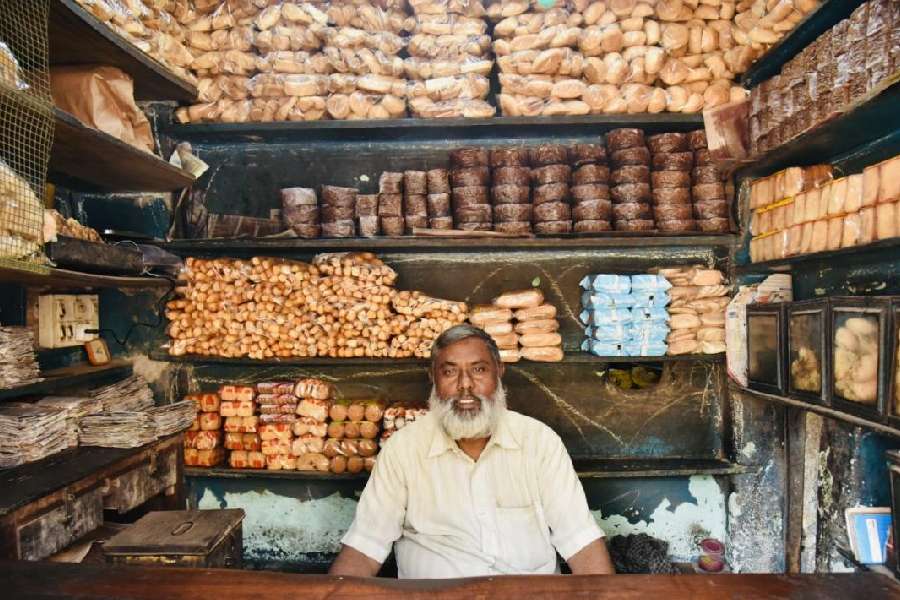
Iftar stalls in Mominpur, near Khidderpore, in Calcutta. Photo by Debabratee Dhar
The shopkeepers are almost done with the first batch of food items, although they themselves are yet to break their fast. Mohammed Yusuf, one of the food stall owners, rattles off items on his menu — cheese croquet, mini samosas, spring rolls, chicken lollipops, Russian cutlets and a chaat made with sprouts. His cousin, Mohammed Ishraf, is fussing over another batch of pantheras, still cooking in a large black iron kadai.
Most of the items are loaded with cheese. Yusuf says, “Cheese is a great favourite.” Another shop is loading display trays with momos and dragon chicken, nothing upwards of ₹50. Then there is chocolate kebab and matka chicken.
The most striking thing about Mominpur at this time of the day is its emptiness. A few people walk past the shops, barely glancing at the food. It is not time yet.Asif Ali, another shopkeeper, says, “Just wait till it’s evening, you will not be ableto walk along these streets.”
Walking down Dent Mission Road in the direction of Ekbalpur Lane, past a madrasa, past Jamhuri Masjid and Islamia Library, you come across another slice of Mominpur market. Here, the food items on sale are a bit more traditional.
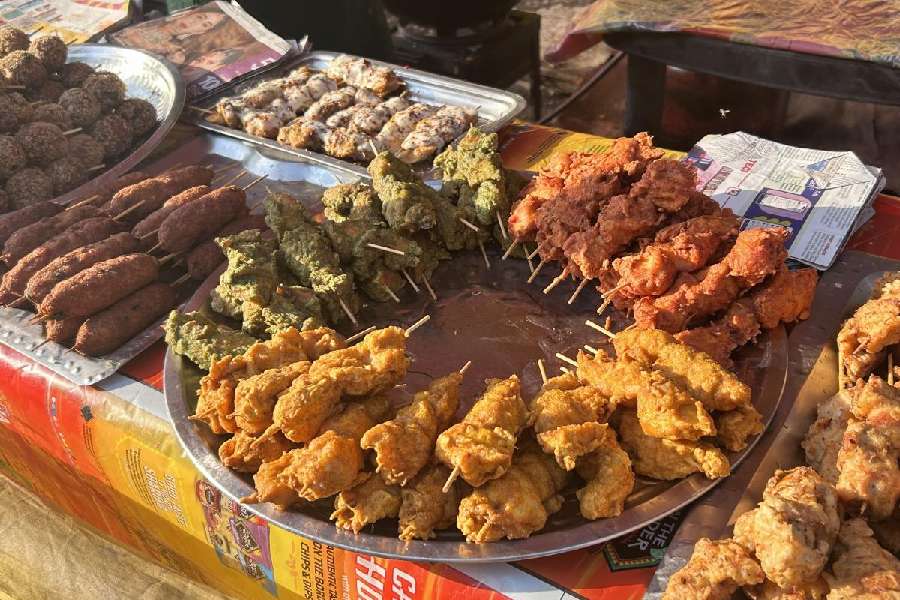
Iftar stalls in Mominpur, near Khidderpore, in Calcutta. Photo by Debabratee Dhar
Tucked in this part of town is K. Ali Bakery. Other than some boxes of toast biscuits, nothing else is on sale. SaysMujibur Rahman, who is one of the owners, “We are only selling fresh batchesof bakarkhani and those too early in the morning.”
Bakarkhani is a crispy flatbread often savoured with chai at sehri, which is the last meal before dawn breaks. Lore has it that a Bengali aristocrat named Aga Bakar Khan named it after his beloved Khani, who was murdered by a rival.
Then there is pink thandai, milk with Rooh Afza, slices of watermelons... Writer and tailor master Ismail Darbesh says, “When I was a little boy, my Abba would get me watermelon or bananas for iftar but now, people are buying kiwi and avocado.”
The delicacies are an occasional feast for those who keep fast. The shops also cater to visitors belonging to all faiths who come all the way to Mominpur to try out the various items on offer.
WALK 2
TIME: 4 pm
PLACE: 7-Point Crossing, Park Circus
The call of azan from Qadri Mosque and Dilkusha Street masjid rise above one another, drown out the noise of traffic. As if on cue, in contrast to the chaos all around, the street arranges itself into an organised marketplace. Stalls selling fruits of only one kind — watermelon, papaya or pineapple — stand next to each other.
“I have been on this road for the last 53 years,” says Yusuf, who is the owner of a sherbet stall. “During Ramzan, you will not find a place to stand on this road.”
Even though Yusuf runs his stall right through the year, most others set up shop just for this month and then disappear.
Next to him stands Dilkhush Faluda on wheels. Faluda is an ice cream dessert served in plastic glasses, mixed with vermicelli, sweet jelly, rose syrup, with a sprinkling of cashews and raisins.
There are about half a dozen stalls with lyrical names such as Arabi Shahi Haleem, Ajmeri Daleem, Lazeez Hyderabadi Shahi Halim.
In the name of different styles of cooking, some of these stalls prepare haleem with dal or cereals, containing either chunks of meat or mashed meat and spices. Each serving is between ₹50 and ₹60, with some shops boasting deals like “Buy 4 Get 1 Free”.
The pavement in front of a big-ticket restaurant has turned into a haleem counter. It stretches from one end of the pavement to the other, yet the sellers claim they will run out of stock by 6pm.
A delivery executive waiting to pick up his food parcel says, “Nowadays people prefer takeaways.” He delivers to the countless offices in the area, to hotels and inns where people check in for a couple of days during Ramzan. Then, there are those who come with their own steel containers, waiting in line for their turn.
Shopkeepers, vendors, labourers, auto drivers, rickshaw pullers — all pull up by the stalls to catch a quick meal.
At this market, things are just getting started. A young man called Bunty is on his way to deliver 20 packs of haleem that hang from the handlebar of his cycle. Before he speeds away, he says, “I will be busy till 4am. That is when the market will close.”
WALK 3
TIME: 5pm
PLACE: Tipu Sultan Mosque, Anwar Shah Road
Just opposite the Hazrat Latif Uddin and Baba Lotba Shanchisti’s shrine at the Prince Anwar Shah crossing there are about eight or nine shops selling sewai or vermicelli. “This is the trend here for the last three decades, if not more,” says an old woman who runs one of the shops.
Her son Ali, who is sitting on the raised platform of one of the makeshift stalls, works as a daily wager. Ali and many others of his ilk have set up shop under bright green, yellow and purple shamianas. “We bring in sewai from Bangalore, Allahabad, Uttar Pradesh and Gujarat,” says an old man, who works in the fruit market at Lords More.
There are various kinds of sewai here. One is the deep-fried variety. These are packed in airtight boxes along with some dry fruits. All you have to do is boil it in milk and add some sugar.
Then there is lachchha sewai. They are round bundles stacked in a heap. This is a ready-to-eat sewai. It is one of the most sold varieties. Others have to be cooked like all other vermicelli.
A couple arrives looking for lachchhas. “Let us pick up 5 kilos of this. We will not get it later,” says Payel to her husband.
As daylight fades, the neon lights inside the shops come on and shine on the immaculate heaps of vermicelli. A pre-ado-lescent boy stands on the elevated wooden deck of his shop, points to his stocks and says, “Theseare from Allahabad; weare saving it for the end of the month when the demand is high.”
“I have procured a very good variety of sewai for Eid,” says Vicky, another shopkeeper. He brings out a green packet from underneath a bedsheet and shoves it back in with the same alacrity and says, “It comes for ₹290 per kilo.”
If you walk ahead towards Jadavpur Police Station you will find old shops on the pavement facing the masjid, serving parathas, kebabs and biryani. Their customers move with an ease that suggests familiarity.
Without much fanfare, they settle down with their meal, served on steel plates and devour it in a hurry. Outside, a man in a white vest and lungi stirs a large, steaming pot of haleem.
Ahead on the footpath, a woman in a sari sits on a stool and fries peyazu and baigni. There are no curious visitors, looking to get a taste of something new.

